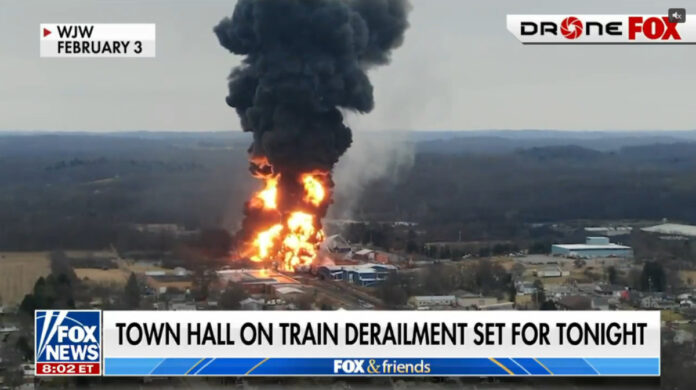
In a previous career, I served on an emergency response team and was peripherally involved in multiple chemical spills, including train derailments, chemical plant fires and explosions, and bomb scares at chemical plants. The most common of these incidents involve things leaking from trucks onto highways or parking lots which are, of course, several magnitudes smaller than ten railcars leaving the tracks in East Palestine, Ohio, and leaking vinyl chloride into the environment. I’m going to use my limited experience to comment on the situation.
In my experience, the chemical industry does a good job of securing its shipments and has a network of responders available across the country to help with clean ups. If a tanker hauling a hazardous material develops a leak, someone calls a toll free number for CHEMTREC and their cleanup experts respond. In many cases, such responders have a good working relationship with local fire officials and they may even hold joint training exercises.
Some large chemical facilities also have their own on-site fire departments, whose members get specialized training and equipment designed to handle the chemicals used on that site. Sometimes, these professionals are also members of volunteer fire departments in the surrounding communities.
Many large cities have first responders trained to handle hazardous materials, but smaller municipalities may not. They will call the closest hazmat team, which will then respond, even if it takes a few hours for them to get there.
Train Derailment
One derailment and leak with which I was involved took place more than 20 years ago. Coincidentally, the train derailed along the Ohio River, but on the West Virginia side. There was no fire, but a cloud of an unidentified gas leaked out of one or more tank cars.
As is often the case, there was a state highway running along the river. Between the river and the highway were the train tracks where the incident happened. I do not recall why the train derailed, but I do remember specifics about the leaking chemicals.
Local responders shut down the highway and the train tracks, which you would expect. They also closed the river to traffic. Then they shut the airspace over the area down, up to at least 5,000 feet. People in the area, including a town on the other side of the river, were told to shelter in place. This may sound like an overreaction, but it was a standard practice for a hazardous materials spill of unknown magnitude.
The biggest complication in the surrounding area was school buses had to drive 45 minutes out of their way to get around the area where the highway was closed. This meant lots of buses were was late, panicking some parents. School switchboards lit up. This was before everyone had a cell phone. Back then, schools didn’t text parents, and Twitter didn’t exist. You had to listen to the local radio to get local news.
The Gas Leak
On site, they identified the gas as sulfuric acid vapor, which can burn your eyes, nasal passages, and lungs. The denser the concentration, the worse it is. Sulfuric acid is also corrosive and you don’t want to get it on exposed skin.
For a couple days, a mist of sulfuric acid rose from the toppled railcars and people were kept away. But once the substance was identified, the five-mile safety zone was reduced to one mile. River and air traffic were allowed to resume. People on the other side of the river returned to their normal daily affairs. In that one-mile radius around the incident, however, people were told to stay indoors or to evacuate if they smelled anything or felt a tickle or burning in their nasal passages.
Within a couple of days, the railroad showed up with empty cars and backed them up to the derailed ones. They pumped the contents of the damaged cars into the empty cars. In addition to stopping the leak by sucking up all the sulfuric acid, this allowed the experts to determine how much acid had escaped into the environment. The amount was in the low hundreds of gallons, if I recall, a surprisingly small amount when you consider the tanker held somewhere around 25,000 or 30,000 gallons each.
Everyone was thankful it was a small leak, a testament to how well those rail cars were designed and built. Subsequent clean up went fast after they removed the hazardous materials from the scene. Cranes righted the cars and repairs were made to the track. I believe the dirt the acid spilled on it was dug out, hauled away, and replaced with clean fill.
The Differences
One obvious difference between this incident and the recent one in East Palestine is that no one set those chemicals on fire. Instead, they recovered the majority and hauled it away. In Ohio, someone decided to burn off the chemicals. The combustion created more chemicals (and arguably more dangerous chemicals) and the resulting thick cloud of smoke apparently dispersed these chemicals from the site of the spill across a wider area. Most of the complaints from locals, including those of rashes, dead animals, and contaminated water, came after the fire.
I am no expert and my limited experience was more than 20 years ago, but it doesn’t take a genius to recognize that the fire took an incident contained in a small area and made it worse.
I think it is important to remember that chemicals like these travel by rail many times per day and most Americans have no idea. Why? Because experts consider rail transit safe and it meets DOT standards.
Before the incident, chemical workers safely loaded the vinyl chloride onto rail cars designed to hold it. Had there been no derailment, it would have been safely unloaded at its destination. Such transfers occur safely multiple times per day at industrial sites across the country. So why was no attempt made to offload the vinyl chloride onto other rail cars or suitable tanker trucks? Who decided a controlled burn was the answer, and did they have any experience managing controlled burns? Why was the resulting fire so big? Did that mushroom cloud look “controlled” to you? Or was it a burn that got out of control?
Those are some of the questions I’d like to see answered.
Why Burn it?
There is plenty of finger pointing at this stage. I’ve read that the railroad recommended the burn. I’ve also heard that the EPA did, although they deny it and blame the local fire chief who served as the incident commander. Even the Ohio governor reportedly approved the idea. My guess is that the incident commander initiated the burn based on the recommendation or others, likely including the EPA and the railroad, with approvals from the governor and other local officials. My guess (again, this is speculation) is the government officials from the fire chief up to the governor did what the experts recommended.
It will probably take a court to assign the blame. Right now, the EPA is forcing Norfolk Southern to pay for the cleanup. But what if it was the EPA that made things worse?
Is the EPA at Fault?
What are the odds that government experts took a bad situation that was contained and made it worse and are now pointing the finger at everyone else? Having occasionally come across pompous federal government officials who think working for a three-letter agency makes them superior to local officials, it wouldn’t surprise me if something like this happened:
Local hazmat experts and railroad officials were managing the incident like they had many others before. They were focused on containment and cleanup. Then the EPA showed up. They were probably desk sitters who were strong on theory and lab results but had little experience with actual chemical spills. Driven by a desire to show the “local yokels” how smart they are, the EPA reps looked at the current efforts and determined the locals failed to identify a potential threat of an explosion. This becomes their primary focus. The EPA reps decided the best way to mitigate the threat was with a controlled burn because that is what the books say to do.
I would speculate that the EPA reps were so focused on preventing an explosion they failed to adequately consider what the unintended consequences of a burn might be, especially a burn of eight tank cars worth of vinyl chloride. Now it’s too late to go back to containment and cleanup just got a lot bigger.
In my opinion, the true environmental disaster in East Palestine is not the chemical spill resulting from the derailment, but the decision to “blow up” the chemicals, releasing far worse chemicals into the atmosphere and over a much larger area.
Who’s fault was that? Was it our government at work?
I’d like to see an investigation. By someone other than the EPA.
Video of the Day
Watch Fox News video that includes video of the chemical fire as seen in the main image, above.







Dioxin – see Mike Adams at naturalnews.com (several videos and discussion)
The EPA states that dioxins are PBTs, which means 1) Persistent. 2) Bioaccumulative. 3) Toxic. This means they don’t go away, they accumulate up the food chain to achieve higher and higher concentrations, and 3) They are toxic.
Via the EPA:
Dioxins are potent toxicants with the potential to produce a broad spectrum of adverse effects in humans. Dioxins can alter the fundamental growth and development of cells in ways that have the potential to lead to many kinds of impacts. These include adverse effects upon reproduction and development, suppression of the immune system, disruption of hormonal systems, and cancer.
The “controlled burn” actually transformed a relatively harmless chemical into an extremely toxic, deadly chemical that will persist across Ohio, Pennsylvania and New York State for CENTURIES.
US Dept of Transportation – 2020 Emergency Response Guidebook (pdf 396 pages)
https://www.phmsa.dot.gov/hazmat/erg/erg2020-english
Combustion of chlorinated compounds always results in the formation of dioxins. This simple fact is known by all competent chemists and is openly admitted by the EPA itself on its dioxins warning page:
https://archive.epa.gov/epawaste/nonhaz/municipal/web/html/health.html
Comments are closed.